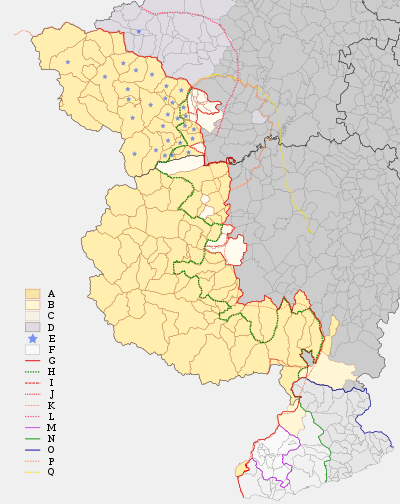
Back Vals Occitanas AN Valles Occitanos AST Traoñiennoù Okitanek Breton Valls Occitanes Catalan Okzitanische Täler German Valles Occitanos Spanish Okzitaniako haranak Basque درههای اکسیتان Persian Vallées occitanes French Valâdes occitanes FRP

The Occitan Valleys (Occitan: Valadas Occitanas; Italian: Valli Occitane; Piedmontese: Valade Ossitan-e; French: Vallées Occitanes; Arpitan: Valâdes Occitanes) are the part of Occitania (the territory of the Occitan language) within the borders of Italy. It is a mountainous region in the southern Alps. Most of its valleys are oriented eastward and descend toward the plains of Piedmont.
The area has a population of 174,476 inhabitants (July, 2013). Its major towns are Lo Borg Sant Dalmatz (Borgo San Dalmazzo), Buscha (Busca), Boves (Bueves) and Draonier (Dronero).
The Occitan linguistic enclave of La Gàrdia (Guardia Piemontese) in Calabria does not belong to the Occitan Valleys.
A 1999 Italian law ("Law 482") provides for the protection of linguistic minorities, including Occitan.[11]
- ^ "La minoranza linguistica occitana" Archived 2015-08-22 at the Wayback Machine, site of the Region of Piedmont.
- ^ "La minoranza linguistica francoprovenzale" Archived 2018-05-13 at the Wayback Machine, site of the Region of Piedmont.
- ^ "La minoranza linguistica francese" Archived 2018-05-14 at the Wayback Machine, site of the Region of Piedmont.
- ^ Girolamo Rossi. Storia del marchesato di Dolceacqua e dei comuni di Pigna e Castelfranco. Oneglia: Tipografia di Giovanni Grilini. 1862. Read online.
- ^ According to the Atlante delle Minoranze Linguistiche del Piemonte e della Provincia di Imperia.
- ^ Enrico Allasino, Consuelo Ferrier, Sergio Scamuzzi, Tullio Telmon. Le lingue del Piemonte.
- ^ Institut d'études occitanes. "Comunas occitanas d'Itàlia", site luòcs.
- ^ Ernst Hirsch. Provenzalische Mundarttexte aus Piemont. Tübingen: Niemeyer Max Verlag GmbH, 1978.
- ^ Franco Bronzat. "Lingua “valdese” e occitano alpino: parentele morfo-fonetiche e lessicali". Bolletino della Società di Studi Valdesi. N°197. Dicembre 2005. pp 69-112.
- ^ Franco Bronzat. "Lingua “valdese” e occitano alpino: parentele morfo-fonetiche e lessicali". Bolletino della Società di Studi Valdesi. N°197. Dicembre 2005. pp 69-112.
- ^ Loi du 15 décembre 1999, no 482 en italien et en français
© MMXXIII Rich X Search. We shall prevail. All rights reserved. Rich X Search